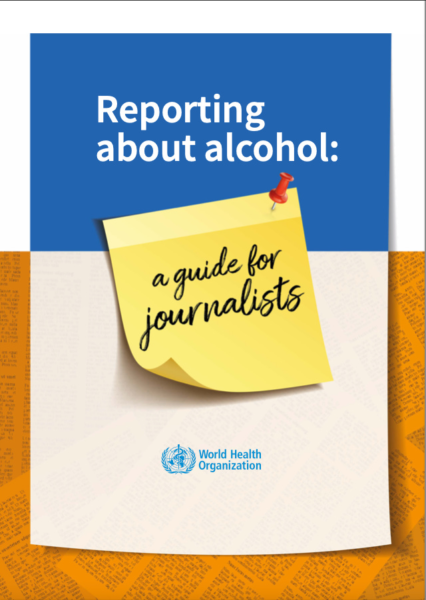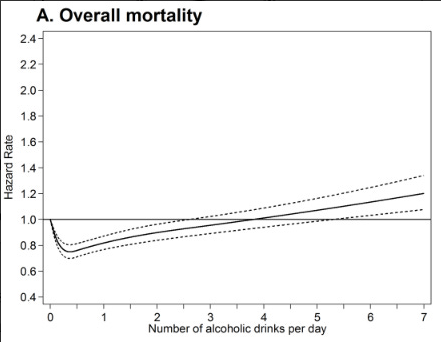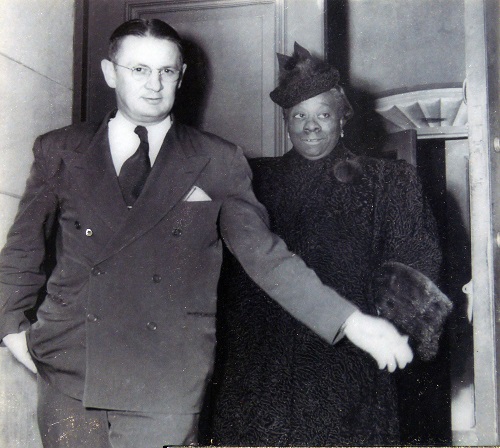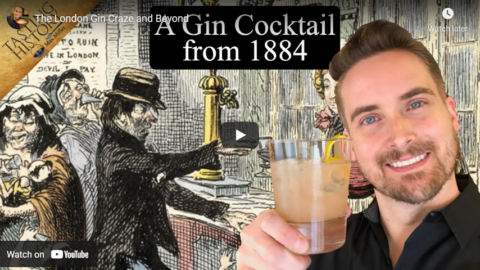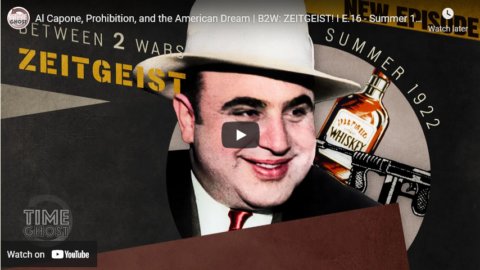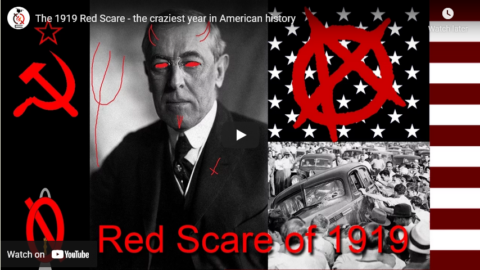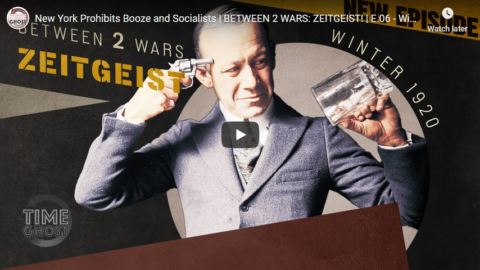Finally, it is 1928. Hoover feels like he has accomplished his goal of becoming the sort of knowledgeable political insider who can run for President successfully. Calvin Coolidge decides not to run for a second term (in typical Coolidge style, he hands a piece of paper to a reporter saying “I do not choose to run for President in 1928” and then disappears and refuses to answer further questions). The Democrats nominate Al Smith, an Irish-Italian Catholic with a funny accent; it’s too early for the country to really be ready for this. Historians still debate whether Hoover and/or his campaign deserves blame for being racist or credit for being surprisingly non-racist-under-the-circumstances.
The main issue is Prohibition. Smith, true to his roots, is against. Hoover, true to his own roots (his mother was a temperance activist) is in favor. The country is starting to realize Prohibition isn’t going too well, but they’re not ready to abandon it entirely, and Hoover promises to close loopholes and fix it up. Advantage: Hoover.
The second issue is tariffs. Everyone wants some. Hoover promises that if he wins, he will call a special session of Congress to debate the tariff question. Advantage: Hoover.
The last issue is personality. Republican strategists decide the best way for their candidate to handle his respective strengths and weaknesses is not to campaign at all, or be anywhere near the public, or expose himself to the public in any way. Instead, they are “selling a conception. Hoover was the omnicompetent engineer, humanitarian, and public servant, the ‘most useful American citizen now alive’. He was an almost supernatural figure, whose wisdom encompasses all branches, whose judgment was never at fault, who knew the answers to all questions.” Al Smith is supremely charismatic, but “boasted of never having read a book”. Advantage: unclear, but Hoover’s strategy does seem to work pretty well for him. He racks up most of the media endorsements. Only TIME Magazine dissents, saying that “In a society of temperate, industrious, unspectacular beavers, such a beaver-man would make an ideal King-beaver. But humans are different.”
Apparently not that different. Hoover wins 444 votes to 87, one of the greatest electoral landslides in American history.
Anne McCormick of the New York Times describes the inauguration:
We were in a mood for magic … and the whole country was a vast, expectant gallery, its eyes focused on Washington. We had summoned a great engineer to solve our problems for us; now we sat back comfortable and confidently to watch our problems being solved. The modern technical mind was for the first time at the head of a government. Relieved and gratified, we turned over to that mind all of the complications and difficulties no other had been able to settle. Almost with the air of giving genius its chance, we waited for the performance to begin.
Scott Alexander, “Book Review: Hoover”, Slate Star Codex, 2020-03-17.
March 11, 2025
QotD: Herbert Hoover wins the presidency
May 30, 2023
Australia’s … deranged … attitudes to vaping
Christopher Snowden describes — because it’s impossible to actually explain — the Australian government’s hysterial and illogical attitude toward vaping:
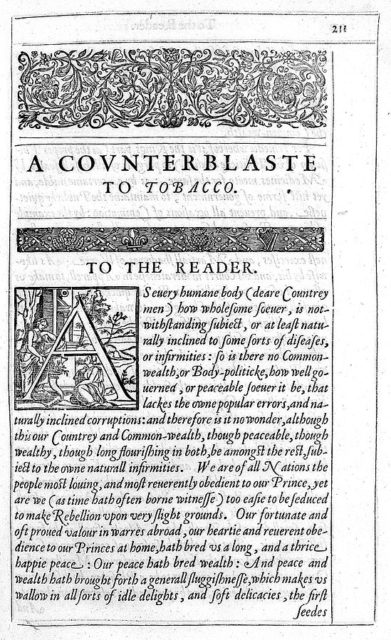
King James I would recognize and approve of Australia’s anti-vaping stance, probably. It would certainly be in the same territory as His Majesty’s pamphlet A Counterblaste to Tobacco where he let his strong feelings be known about “so vile and stinking a custom”.
For the past decade, Australian newspaper articles about e-cigarettes have seemed like communiqués from another dimension. The term “moral panic” is over-used, but how else can you describe a situation in which people are so terrified of safer nicotine delivery devices that doctors give their children cigarettes to stop them vaping?
The sale of nicotine e-cigarettes has always been banned in Australia. Prohibition is the default and, along with the highest cigarette taxes in the world, it has led to a huge black market in vapes (and, indeed, in tobacco). It appears that many teenagers are vaping there and what they are vaping is unregulated.
The Aussies could have done what New Zealand did and legalise e-cigarettes. Instead, they doubled down and banned the importation of nicotine vapes for personal use. That didn’t work so they are now banning the sale of all the remaining (i.e. non-nicotine) disposable vapes. Something tells me that won’t work either, but the government is so far down the rabbit hole it can only keep digging.
Their politicians have convinced themselves that “Big Tobacco” is getting a new generation of Aussies hooked on killer vapes with aggressive marketing. It’s a paranoid delusion. There is no e-cigarette marketing in Australia. The products flooding the black market are coming straight from China, not from “Big Tobacco”. And insofar as the products are dangerous it is because they are totally unregulated.
Down this road lies madness but if the Australians want to go down it, that’s up to them. I have no plans to go back there. As an Australian reader said to me recently, “Go and see a Kangaroo at a zoo. Don’t even waste a single dollar on ‘tourism’ of the doomed failed state of what’s become of Australia.”
But while the Aussies can go to Hell in whatever handcart they like, I don’t appreciate them pushing their nonsense on the rest of us, as the BBC’s recently appointed Sydney correspondent has done today with an article titled “Why Australia decided to quit its vaping habit“.
From the outset, it is clear that the author has spent too long Down Under.
Despite vapes already being illegal for many, under new legislation they will become available by prescription only.
The number of vaping teenagers in Australia has soared in recent years and authorities say it is the “number one behavioural issue” in schools across the country.
And they blame disposable vapes — which some experts say could be more addictive than heroin and cocaine — but for now are available in Australia in every convenience store, next to the chocolate bars at the counter.
Some experts? Do they have names? People say a lot of things. The job of a journalist is to find out which ones are telling the truth.
And if e-cigarettes are illegal, why are they available “in every convenience store”? This sounds like an enforcement issue that isn’t going to be solved by more prohibition.
April 21, 2023
The Neo-Prohibitionists have taken over the World Health Organization
Christopher Snowden illustrates some of the deliberate lies promulgated by the World Health Organization’s anti-alcohol activists:
The incompetent and corrupt World Health Organisation has produced a “guide for journalists” to help hacks report on issues related to alcohol accurately. Not entirely unpredictably, it is a catalogue of anti-drinking tropes, half-truths and brazen lies. The very first words are “No amount of alcohol is safe to drink” and it doesn’t get any better thereafter.
The health benefits of moderate alcohol consumption really stick in the craw of the neo-temperance lobby and so that is where the WHO starts:
Isn’t drinking some alcohol good for your health?
No, there is no evidence for the common belief that drinking alcohol in moderate amounts can help people live longer by decreasing their risk of heart disease, diabetes, stroke or other conditions.
No evidence?! Even a casual follower of the science knows that there is at least some evidence. Those who are more familiar with the literature know that there is a huge amount of evidence built up over decades, tested and re-examined from every angle precisely because so many people in ‘public health’ don’t want to believe it.
It is inaccurate to say that “experts are divided” on whether there is no amount of healthy alcohol drinking. The scientific consensus is that any level of alcohol consumption, regardless of the amount, increases risks to health.
This is just a lie. That is not the consensus, and the only reason there isn’t unanimous agreement that moderate drinking is beneficial to health is that anti-alcohol academics such as Tim Stockwell have made it their life’s work to cast doubt on the evidence.
While several past studies did suggest that moderate consumption could, on average, promote health benefits …
Note that this immediately contradicts the claim that there is no evidence.
… newer research (1) shows that those studies used limited methodologies and that many of them were funded by the alcohol industry (2).
The first reference is a short commentary by some WHO staffers which doesn’t discuss methodologies at all. The second reference is a study which found that only 5.4 per cent of research papers in this area were funded by the alcohol industry and concluded that “the association between moderate alcohol consumption and different health outcomes does not seem to be related to funding source.”
The WHO must hold journalists in low esteem if it thinks they won’t check up the citations like this.
The dicussion [sic] about possible so-called protective effects of alcohol diverts attention from the bigger picture of alcohol harm; for example, even though it is well established that alcohol can cause cancer, this fact is still not widely known to the public in most countries (3).
The “bigger picture” is overall mortality. When all the risks are taken into account, including the small risks from a few rare cancers, do moderate drinkers live longer than teetotallers? Yes. Yes, they do.
January 8, 2023
Caesar Salad and Satan’s Playground
The History Guy: History Deserves to Be Remembered
Published 7 Sep 2022The rare example of a food fad that has maintained its popularity, the tangy dressing on romaine lettuce salad has a history as rich as a coddled egg, involving multiple nations, a bevy of movie stars, an infamous American divorcee, a disputed origin story, and, prominently, alcohol. And, perhaps surprising to many, is unrelated to the notorious Roman dictator.
(more…)
October 29, 2022
The Absinthe Murder
Tasting History with Max Miller
Published 28 Jun 2022
(more…)
September 7, 2022
The Original Caesar Salad from Mexico
Tasting History with Max Miller
Published 6 Sep 2022
(more…)
September 2, 2022
The winner in 1932 campaigned against high taxes, big government, and more debt. Then he turned all those up to 11
At the Foundation for Economic Education, Lawrence W. Reed notes that we often get the opposite of what we vote for, and perhaps the best example of that was the 1932 presidential campaign between high-taxing, big-spending, government-expanding Republican Herbert Hoover and Franklin Delano Roosevelt, who ran against all of Hoover’s excesses … until inauguration day, anyway:
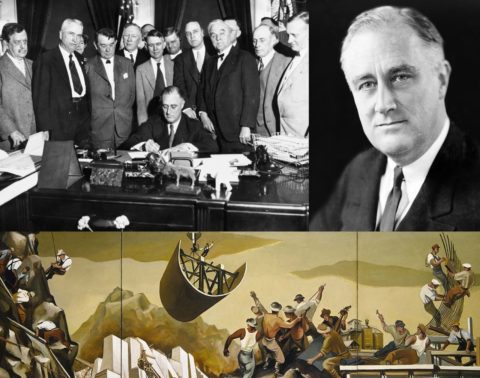
Top left: The Tennessee Valley Authority, part of the New Deal, being signed into law in 1933.
Top right: FDR (President Franklin Delano Roosevelt) was responsible for the New Deal.
Bottom: A public mural from one of the artists employed by the New Deal’s WPA program.
Wikimedia Commons.
If you were a socialist (or a modern “liberal” or “progressive”) in 1932, you faced an embarrassment of riches at the ballot box. You could go for Norman Thomas. Or perhaps Verne Reynolds of the Socialist Labor Party. Or William Foster of the Communist Party. Maybe Jacob Coxey of the Farmer-Labor Party or even William Upshaw of the Prohibition Party. You could have voted for Hoover who, after all, had delivered sky-high tax rates, big deficits, lots of debt, higher spending, and trade-choking tariffs in his four-year term. Roosevelt’s own running mate, John Nance Garner of Texas, declared that Republican Hoover was “taking the country down the path to socialism”.
Journalist H.L. Mencken famously noted that “Every election is a sort of advance auction sale of stolen goods.” If you agreed with Mencken and preferred a non-socialist candidate who promised to get government off your back and out of your pocket in 1932, Franklin Roosevelt was your man — that is, until March 1933 when he assumed office and took a sharp turn in the other direction.
The platform on which Roosevelt ran that year denounced the incumbent administration for its reckless growth of government. The Democrats promised no less than a 25 percent reduction in federal spending if elected.
Roosevelt accused Hoover of governing as though, in FDR’s words, “we ought to center control of everything in Washington as rapidly as possible.” On September 29 in Iowa, the Democrat presidential nominee blasted Hooverism in these terms:
I accuse the present Administration of being the greatest spending Administration in peace times in all our history. It is an Administration that has piled bureau on bureau, commission on commission, and has failed to anticipate the dire needs and the reduced earning power of the people. Bureaus and bureaucrats, commissions and commissioners have been retained at the expense of the taxpayer.
Now, I read in the past few days in the newspapers that the President is at work on a plan to consolidate and simplify the Federal bureaucracy. My friends, four long years ago, in the campaign of 1928, he, as a candidate, proposed to do this same thing. And today, once more a candidate, he is still proposing, and I leave you to draw your own inferences. And on my part, I ask you very simply to assign to me the task of reducing the annual operating expenses of your national government.
Once in the White House, he did no such thing. He doubled federal spending in his first term. New “alphabet agencies” were added to the bureaucracy. Nothing of any consequence in the budget was either cut or made more efficient. He gave us our booze back by ending Prohibition, but then embarked upon a spending spree that any drunk with your wallet would envy. Taxes went up in FDR’s administration, not down as he had promised.
Don’t take my word for it. It’s all a matter of public record even if your teacher or professor never told you any of this. For details, I recommend these books: Burton Folsom’s New Deal or Raw Deal; Murray Rothbard’s America’s Great Depression; my own Great Myths of the Great Depression; and the two I want to tell you about now, John T. Flynn’s As We Go Marching and The Roosevelt Myth.
For every thousand books written, perhaps one may come to enjoy the appellation “classic”. That label is reserved for a volume that through the force of its originality and thoroughness, shifts paradigms and serves as a timeless, indispensable source of insight.
Such a book is The Roosevelt Myth. First published in 1948, Flynn’s definitive analysis of America’s 32nd president is arguably the best and most thoroughly documented chronicle of the person and politics of Franklin Delano Roosevelt. Flynn’s 1944 book, As We Go Marching, focuses on the fascist-style economic planning during World War II and is very illuminating as well.
June 5, 2022
Odessa Madre, the female Al Capone of Washington DC
In his latest excerpt from the full Weekly Dish, Andrew Sullivan reviews a new book from James Kirchick, Secret City: The Hidden History of Gay Washington, including a fascinating character I’d never heard of until now, a woman who ranked with Al Capone as an underworld boss during Prohibition:
Odessa Madre grew up in a section of Washington DC called Cowtown, because farm animals would occasionally wander its streets. Born in 1907 in abject poverty, she nonetheless lived and thrived in a deeply segregated city as a dark-skinned African-American woman. “There was only three Blacks at Dunbar (High School) back then — I mean Black like me,” she later recalled. “I had good diction, I knew the gestures, but they still made fun of me.” Dess, as many called her, was also a lesbian, and not too shy about it. “I just couldn’t keep no watchamacallit — a man. I guess I was just born to give orders not take them. What kind of man wants a woman like that?”
She went on to become one of the wealthiest African Americans in an overwhelmingly black city — hauling in over $100,000 a year at her peak — by becoming “the female Al Capone”. She ran brothels, pimped women, owned speakeasies, as well as owning a legit and legendary institution on 14th Street, Club Madre. Jamie Kirchick conjures up a scene from the 1940s:
The crowd roared its approval whenever Madre, covered in mink furs and diamonds and trailed by a multiracial retinue of women for sale, entered the premises and sauntered over to the central table, denoted as hers by an ever-present vase holding a dozen long-stemmed roses.
Among the performers at the club: Billie Holiday, Duke Ellington and Count Basie. Madre kept all her illicit businesses alive by the old-fashioned method of bribing the fathomlessly corrupt DC police — “You know I practically ran that damn police department,” she later quipped — and became a renowned mediator of mob disputes across the country.
She also reflects a pattern that occurs throughout Kirchick’s new book, Secret City: The Hidden History of Gay Washington. She is within a core group of lesbians and gay men somehow living their best lives in the mid-20th Century, simultaneously at the center and the periphery of power. They were capable, whip-smart and hard-working, resilient beyond measure, yet never free from the threat of being taken down by the criminal law, exposure, blackmail, violence, public shaming and utter ostracism. Madre was convicted in 1949 on various drug offenses, spent over 13 years in prison on one charge or other, and died in 1990, without a penny to her name. Her corpse stayed in the morgue for a week until someone claimed it.
The same terrible story could be told of countless others. They were powerful until they were powerless. They lived on probation their entire lives.
One of several wonderful things about Kirchick’s book is that it doesn’t condescend to these people, but seeks to understand them on their own terms. It shows the tenacity, nerve, and brilliance of a woman like Madre — as well as her immiseration. It brings to crackling life the many gay men and lesbians who were under persecution so brutal and terrifying it is hard for anyone today to appreciate — and yet they lived, worked, loved and often succeeded. Some details (from the magazine, Washington Confidential) leap out:
Today one can only marvel at the courage demonstrated by the “1700 Negro men, all dressed as women, who held a party on a Potomac River cruise incongruously named the Robert E Lee until it was rudely interrupted ben one hundred police officers.
It’s a rare book about gay people that isn’t burdened by the constrictive dogma of “queer theory” and “intersectionality”, free of the nonsense that the gay rights movement began in 1969. The book treats gay people as complex human beings, not socially constructed victims; and it is unafraid to note how gay men were for long by far the principal targets of American persecution.
November 10, 2021
QotD: Pershing and Prohibition
Despite its profound effects on American society – and the modern romanticization of the era as one of speakeasies, flappers, and pinstriped gangsters – Prohibition had surprisingly little resonance within the U.S. Army.
There are two primary reasons for this. First, the Army had been living under various forms of prohibition long before the 18th Amendment’s ratification. In 1832, during the Black Hawk War, Illinois militiamen consumed their entire two-week issue of whiskey by the campaign’s second day. When Black Hawk attempted to surrender that day, the drunken militia instead attacked, and in the ensuing “Battle of Stillman’s Run” Black Hawk and his roughly fifty warriors routed the 275 militiamen. Consequently, Andrew Jackson’s Secretary of War Lewis Cass eliminated the whiskey ration.
As the temperance movement gained increasing influence, in 1890, Congress banned “intoxicating beverages” to enlisted men at military posts located in states, territories, or counties with local prohibition laws. The Army considered beer and light wines to be non-intoxicating, however, and allowed their sale and consumption at the post commander’s discretion. Congress subsequently expanded Army prohibition with the so-called Canteen Act of 1901, which forbade “the sale of, or dealing in, beer, wine or any intoxicating liquors by any person in any post exchange or canteen or army transport or upon any premises used for military purposes by the United States.” When America entered World War I, Congress extended alcoholic prohibition beyond the Army’s post boundaries. The Selective Service Act of May 1917 prohibited intoxicating beverages “in or near military camps” – which the War Department implemented by establishing a prohibition zone five miles wide around each post – and made it illegal to sell to any serviceman in uniform. (The Army once again skirted the bill’s intent by permitting beverages with less than 1.4 percent alcohol-by-volume). Thus, the 18th Amendment had little legal impact on the US. Army.
More importantly, perhaps, was the fact that like millions of their civilian counterparts, most officers and enlisted men simply chose to ignore the Volstead Act’s enforcement of Prohibition. When General Pershing became Army Chief of Staff, each day after leaving the War Department he enjoyed staying up late with his aides, drinking, talking about his youth, and joking. Once when he and George Marshall were traveling on a train together and enjoying a bottle of Scotch, Pershing suggested they offer some to Senator George Moses in the next car. Pouring a little into a glass, they proceeded to where Pershing thought Moses was sleeping in a Pullman. “Senator Moses,” whispered Pershing as he scratched a berth’s closed green curtain. When there was no answer, Pershing raised the curtain, only to discover not Senator Moses, but an angry woman who cried: “What do you want?” Pershing dropped the curtain and bolted down the aisle like a frightened schoolboy, pushing Marshall ahead of him and spilling the scotch. “I had a hard time keeping out of his way,” Marshall said, “because he was running up my back. But we got to the stateroom and got the door shut. Then he just sat down and laughed until he cried.” Finally, wiping his eyes, Pershing noticed a little Scotch remained in the glass and mischievously suggested Marshall return and try it again. Not on your life, Marshall replied. “Get another aide.”
Benjamin Runkle, “‘What a Magnificent Body of Men Never to Take Another Drink’: The U.S. Army and Prohibition”, Real Clear Defense, 2019-01-16.
October 9, 2021
The London Gin Craze and Beyond
Tasting History with Max Miller
Published 26 Jan 2021Help Support the Channel with Patreon: https://www.patreon.com/tastinghistory
Tasting History Merchandise: crowdmade.com/collections/tastinghistoryFollow Tasting History here:
Instagram: https://www.instagram.com/tastinghist…
Twitter: https://twitter.com/TastingHistory1
Tiktok: TastingHistory
Reddit: r/TastingHistory
Discord: https://discord.gg/d7nbEpy
Ketchup with Max: https://www.youtube.com/channel/UC1DL3SXDAdrQs2WE4AMD4SwLINKS TO SOURCES**
Gin: The Much-lamented Death of Madam Geneva by Patrick Dillon: https://amzn.to/39VxZU7
Gin: A Global History by Lesley Solmonson: https://amzn.to/3c8sJzc
The Diary of Samuel Pepys: https://amzn.to/391W64u
The Fable of Bees by Bernard Mandeville: https://amzn.to/3c13Eq8
Sketches by Boz by Charles Dickens: https://amzn.to/3sTMUar**Amazon offers a small commission on products sold through their affiliate links, so each purchase made from this link, whether this product or another, will help to support this channel with no additional cost to you.
Subtitles: Jose Mendoza
MUSIC
“Divertissement” by Kevin MacLeod is licensed under a Creative Commons Attribution 4.0 license. https://creativecommons.org/licenses/…
Source: http://incompetech.com/music/royalty-…
Artist: http://incompetech.com/#tastinghistory #gin #cocktail #gincraze
September 23, 2021
Nazi Fanatics and Gangland Executions | B2W: ZEITGEIST! I E.26 Winter 1925
TimeGhost History
Publisheed 22 Sep 2021The winter of 1925 is a season of gun battles and assassinations. Al Capone is fighting both the Chicago police and rival gangs to gain control of the bootlegging racket, and a Nazi party fanatic murders a Viennese author for his writings on anti-Semitism and eroticism. It’s not all violence, though. This season, a landmark documentary film is released.
(more…)
April 22, 2021
Al Capone, Prohibition, and the American Dream | B2W: ZEITGEIST! I E.16 – Summer 1922
TimeGhost History
Published 21 Apr 2021The Prohibition era is still just getting started, but criminal enterprises have already sprung up everywhere to supply thirsty Americans with their drink. In the “summer of sin” of 1922, one man in particular is making waves in the Chicago underworld.
Join us on Patreon: https://www.patreon.com/TimeGhostHistory
Hosted by: Indy Neidell
Written by: Francis van Berkel
Director: Astrid Deinhard
Producers: Astrid Deinhard and Spartacus Olsson
Executive Producers: Astrid Deinhard, Indy Neidell, Spartacus Olsson, Bodo Rittenauer
Creative Producer: Maria Kyhle
Post-Production Director: Wieke Kapteijns
Research by: Francis van Berkel and Lewis Braithwaite
Image Research by: Daniel Weiss
Edited by: Daniel Weiss
Sound design: Marek KamińskiColorizations:
Daniel Weiss – https://www.facebook.com/TheYankeeCol…Sources:
Library of CongressSoundtracks from Epidemic Sound
– “One More for the Road” – Golden Age Radio
– “London” – Howard Harper-Barnes
– “Infinity Pool & Pool Tables” – Mythical Score Society
– “Rush of Blood” – Reynard Seidel
– “It’s Not a Game” – Philip Ayers
– “Please Hear Me Out STEMS INSTRUMENTS” – Philip Ayers
– “Not Safe Yet” – Gunnar Johnsen
– “On the Edge of Change” – Brightarm Orchestra
– “British Royalty” – Trailer Worx
– “Break Free” – Fabien Tell
– “Steps in Time” – Golden Age Radio
– “Magnificent March 3” – Johannes BornlöfArchive by Screenocean/Reuters https://www.screenocean.com.
A TimeGhost chronological documentary produced by OnLion Entertainment GmbH.
From the comments:
TimeGhost History
3 days ago
As you hopefully realized from the title, thumbnail, description, and first words coming out of Indy’s mouth, a big focus of this episode is the beginning of the gangland Prohibition era and the rise of Al Capone.It’s a fascinating topic, but something else to draw attention to in this episode is the Catholic Church’s campaign against modernity. Last episode we saw how religion was forced into retreat by the Bolshevik regime in Russia, well this episode we’re seeing one of the oldest religious institutions in the world make its fightback. It shows that the story of modernity isn’t just “old things” fading away and being replaced by “new things”. Instead, it is a story of continual tension, negotiation, and adaption, between the old and the new.
Anyway, philosophical musings on religion aside, this really is an exciting episode and there will be much more on Al Capone and the Beer War in years to come.
April 5, 2021
The 1919 Red Scare – the craziest year in American history
The Cynical Historian
Published 19 May 2016Many people have heard of the first Red Scare, but we should look at the year of 1919 more thoroughly. It’s probably the craziest one in American history.
Ann Hagedorn, Savage Peace: Hope and Fear in America, 1919 (New York: Simon & Schuster Paperbacks, 2007). https://amzn.to/2NHIcaT
————————————————————
contribute to my Patreon:
https://www.patreon.com/CynicalHistorianLET’S CONNECT:
https://twitter.com/Cynical_History
————————————————————
wiki:
The First Red Scare was a period during the early 20th-century history of the United States marked by a widespread fear of Bolshevism and anarchism, due to real and imagined events; real events included those such as the Russian Revolution. At its height in 1919–1920, concerns over the effects of radical political agitation in American society and the alleged spread of communism and anarchism in the American labor movement fueled a general sense of paranoia.The Scare had its origins in the hyper-nationalism of World War I as well as the Russian Revolution. At the war’s end, following the October Revolution, American authorities saw the threat of Communist revolution in the actions of organized labor, including such disparate cases as the Seattle General Strike and the Boston Police Strike and then in the bombing campaign directed by anarchist groups at political and business leaders. Fueled by labor unrest and the anarchist bombings, and then spurred on by United States Attorney General A. Mitchell Palmer’s attempt to suppress radical organizations, it was characterized by exaggerated rhetoric, illegal search and seizures, unwarranted arrests and detentions, and the deportation of several hundred suspected radicals and anarchists. In addition, the growing anti-immigration nativism movement among Americans viewed increasing immigration from Southern Europe and Eastern Europe as a threat to American political and social stability.
Bolshevism and the threat of a Communist-inspired revolution in the U.S. became the overriding explanation for challenges to the social order, even such largely unrelated events as incidents of interracial violence. Fear of radicalism was used to explain the suppression of freedom of expression in form of display of certain flags and banners. The First Red Scare effectively ended in mid-1920, after Attorney General Palmer forecast a massive radical uprising on May Day and the day passed without incident.
————————————————————
Hashtags: #History #1919 #RedScare #SpanishFlu #Bolshevism #BlackSox #strikes #WoodrowWilson #LeagueOfNations #prohibition #suffrage
[Note: this was filmed in 2016 … I think 2020 has now taken the mantle of “craziest year”. Unless 2021 doubles down all the weirdness of 2020.]
December 3, 2020
September 21, 2020
QotD: Prohibition and the Temperance movement
Prohibition was the culmination of nearly a century’s worth of propaganda, and repeated failed attempts to get such laws to work at the local and state level. Read J.C. Furnas’ The Life and Times of the Late Demon Rum for an overview of the pre-1919 Temperance/Prohibition movement.
… [T]he original Temperance movement started out with the very best of intentions, and was trying to deal with a real problem. In colonial and early-19th-century America, people (men, women and OH HORRORS even children!) drank enough that by modern standards we’d call them alcoholics. Modern Russians drink more, but if they were transported back to that time and place, they’d fit right on in. Part of it was because water was often not safe to drink (tea and coffee were often expensive and hard to get, while beer and other alcoholic drinks were made just about everywhere), part of it was snobbery (only really poor people drank water!) and part of it was because people back then believed that alcohol strengthened and warmed the body.
Two of the good side effects of the Temperance/Prohibition movement were the provision of safe, clean drinking water in American cities and towns, and the modern fruit-juice industry (as a lot of churches went hot-Prohibition, they got uneasy about serving wine at Communion, so they went to work and came up with non-alcoholic substitutes.) Welch’s Grape Juice was started by a pastor who wanted non-alcoholic “wine” for Communion, and caught on, real big.
Eric Oppen, posting to the Lois McMaster Bujold mailing list, 2020-06-18.

